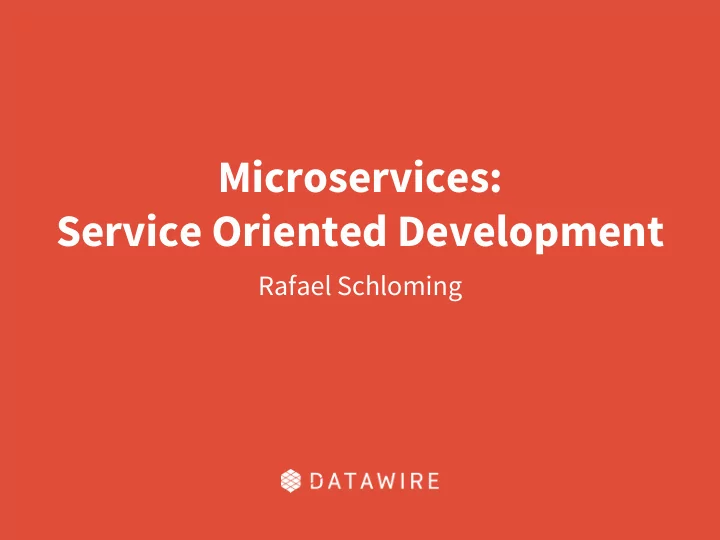

Microservices: Service Oriented Development Rafael Schloming
How do I break up my monolith? How do I architect my app with microservices? What infrastructure do I need in place before I can benefit from microservices? datawire.io 2
Microservices at Datawire ... Building a cloud application using ● microservices in 2013 Distributed systems engineers ● Multiple services ● Prototyping was really fast ● … then we launched and things ● slowed down… datawire.io 3
Debugging Velocity (or lack thereof) datawire.io 4
Tooling Architecture Process!!! datawire.io 5
Debugging our Pipeline datawire.io 6
Velocity comes from Process, not Architecture datawire.io 7
Service Oriented Architecture Service Oriented Development datawire.io 8
Stability/Maturity Velocity Prototype Production Mission critical datawire.io 9
Stability/Maturity Velocity Prototype Production Mission critical datawire.io 10
A single process is inefficient (Forces a single Stability vs Velocity Tradeoff) datawire.io 11
Code Test Define Release Prod datawire.io 12
Code Test Define Centralized process Specialized teams ● Fixed policies (e.g., ● release criteria) Release Prod datawire.io 13
A single process doesn’t scale datawire.io 14
How do I break up my monolith? How do I break up my process ? datawire.io 15
Microservices lets you run multiple processes! datawire.io 16
Microservices is a distributed development architecture workflow. datawire.io 17
How do I get to Continuous Deployment incrementally? ● How do I limit the scope of PCI (audit process)? ● How do I ship feature X as fast as possible? ● Stability/Maturity Velocity Prototype Production Mission critical datawire.io 18
Microservices is ... ● Multiple workflows ○ Including your existing workflow! ○ Workflows designed for different stability/velocity tradeoffs ● Simultaneous workflows datawire.io 19
Doing things this way shifts how people operate! Requires both organizational and technical changes ● datawire.io 20
Organizational Implementation datawire.io 21
You gotta give in order to get Education Everyone exposed to full dev cycle ● Communication Nobody speaks the same language ● Delegation Small teams own big important parts ● datawire.io 22
But you get a lot Education Specialists become generalists -> Better holistic systems ● Learning, personal growth -> Job satisfaction ● Communication Conflict -> Collaboration ● Delegation Massive organizational scale ● datawire.io 23
Create self-sufficient, autonomous software teams . datawire.io 24
Why self-sufficiency and autonomy? Self-sufficient ● Team does not need to rely on other teams to achieve its goals ○ Autonomy ● Team is able to independently make (process) decisions on how to achieve its goals ○ datawire.io 25
Eliminate centralized specialist functions Centralized infrastructure / ops* Centralized architecture (You might need a platform team) datawire.io 26
Think Spinoff datawire.io 27
Monolith datawire.io 28
Microservice Team Monolith datawire.io 29
Technical Implementation datawire.io 30
The Workflows Production Users Stage Prototype Mission Critical & Growth Add Features Fast Feedback & Goals from both Stability Don’t Disrupt Tools & Users Users datawire.io 31
One Platform, Parallel Workflows, Seamless Transitions Stage 1: Rapid Stage 3: Internal Stage 1: Rapid Stage development, Stage 2: Users Stage 3: Internal Stage 1: Rapid users, coupling development, Stage 2: Users early users Stage 3: Internal users, coupling development, Stage 2: Users early users Production Users users, coupling Prototype Mission Critical early users & Growth Minimal No cascade Minimal Goals Doesn’t crash... disruption to No cascade Minimal failures... Add Features Doesn’t crash... disruption to No cascade users... Fast Feedback failures... Doesn’t crash... disruption to & users... failures... from both Stability users... Don’t Disrupt Tools & Users Users datawire.io 32
Kubernetes / Docker / Envoy give you the infra you need datawire.io 33
How do I actually use these technologies to build my workflows? datawire.io 34
Stage 1: Prototyping Goal: Fast Feedback from both Tools and Users Org Problem: You need buy-in for prototyping in production Tech Problem: You can’t run microservices locally datawire.io 35
Strategy: Self Service Provisioning & Development Containers datawire.io 36
Provide fast self-service provisioning Make this fast and easy! Too much friction leads to accidental coupling ● datawire.io 37
Problem: Coding on remote infra is slow... VM based pipeline: Deploy time: maybe 45 minutes? ● Docker based pipeline: Deploy time: maybe a few minutes? ● Hacking react on my laptop with live reload: Maybe 1-2 seconds? ● Hacking flask on my laptop with live reload: Instantaneous ● datawire.io 38
How can we do better? datawire.io 39
Develop inside a container Helps with onboarding and jumping between services: Single source of truth for build & dependencies ● Consistent and portable dev environment ● You can make a faster feedback loop: 1. Sync local files -> remote build 2. Sync local files -> local build; snapshot image; deploy in seconds 3. Sync local files -> local build; proxy into remote cluster Shameless self promotion: See https://forge.sh for (2) and https://telepresence.io for (3) ● datawire.io 40
Fast Deploy == Resilience datawire.io 41
Stage 2: Production Users & Growth Goal: Add Features & Don’t Disrupt Users Org Problems: Recognize the Tradeoff & How to measure user impact Tech Problem: Software Bugs datawire.io 42
Strategy: Genetic Diversity (Multiversion Deployment) datawire.io 43
Multiple versions for software redundancy Primary version Canary version End user Dev version datawire.io 44
Stage 3: Mission Critical Goal: Stability Org Problem: Avoid regressing Tech Problem: L7 Observability datawire.io 45
Strategy: Service Level Objectives & L7 Observability datawire.io 46
Cascade Failures X A B C D E datawire.io 47
Summary 1. Start with: “How do I break up my monolithic process?” 2. Spinoff self sufficient & autonomous teams 3. Build awesome tooling for Service Oriented Development datawire.io 48
Thank you! rhs@datawire.io ● If you want to learn more about these ideas, check out our hands-on tutorial here: ● https://datawire.io/faster ○ If you’re interested in any of our open source tools, check them out: ● https://forge.sh for deployment ○ https://www.telepresence.io for real-time live coding ○ https://www.getambassador.io self-service API Gateway built on Envoy ○ datawire.io 49
END
Recommend
More recommend